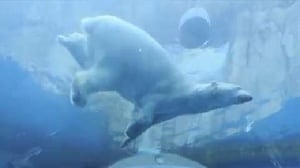A list of my favorite images of polar bears.
List #2 may be viewed here: www.listal.com/list/favorite-images-polar-bears-2
en.wikipedia.org/wiki/Polar_bear
The polar bear (Ursus maritimus) is a carnivorous bear whose native range lies largely within the Arctic Circle, encompassing the Arctic Ocean, its surrounding seas and surrounding land masses.
It is a large bear, approximately the same size as the omnivorous Kodiak bear (Ursus arctos middendorffi). A boar (adult male) weighs around 350–700 kg (772–1,543 lb), while a sow (adult female) is about half that size.
Although it is the sister species of the brown bear, it has evolved to occupy a narrower ecological niche, with many body characteristics adapted for cold temperatures, for moving across snow, ice and open water, and for hunting seals, which make up most of its diet.
Although most polar bears are born on land, they spend most of their time on the sea ice. Their scientific name means "maritime bear" and derives from this fact.
Polar bears hunt their preferred food of seals from the edge of sea ice, often living off fat reserves when no sea ice is present. Because of their dependence on the sea ice, polar bears are classified as marine mammals.
Because of expected habitat loss caused by climate change, the polar bear is classified as a vulnerable species and at least three of the nineteen polar bear subpopulations are currently in decline.
For decades, large-scale hunting raised international concern for the future of the species but populations rebounded after controls and quotas began to take effect.
For thousands of years, the polar bear has been a key figure in the material, spiritual and cultural life of circumpolar peoples, and polar bears remain important in their cultures.
Added to
People who voted for this also voted for
Cigarette Cards: Film Personalities (1930)
some pictures i add 2015
Winter (2014) in South Dakota (USA)
Escalator Scenes - Movies
images from hilton head island, south carolina
Crucifix Scenes - Movies
Christmas Cuties IX, Retro II (2014)
Banff National Park, Alberta, Canada
When I was 32... book diary, Nov/Dec 2015
Mugshot (Moments and Photos) - Movies
Lito Leaf Art
Lamp
DC Comics' "Dean Martin And Jerry Lewis"_1954/1955
When I was 32... music diary, Jan/Feb/Mar 2016
Ferryboat - Movies
More lists from kathy
Favorite Images of Beverages
Favorite Images of Celebrities with Animals #9
Favorite Images of Towel Origami Animals
Favorite Underwater Images
Favorite Paintings of Flowers
Favorite Images of Furry Friends #5
Favorite Images of Red Pandas
 Login
Login































































